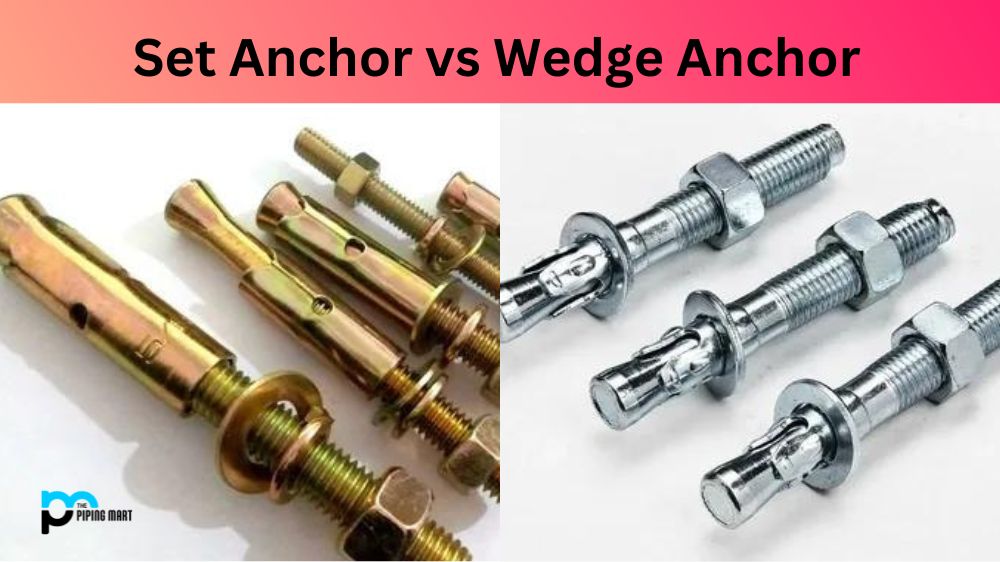Set Anchor vs Wedge Anchor – What’s the Difference
| 11:10 pm


Table of Contents
If you plan to attach something to a solid surface, you have to ensure it stays there. There are many ways to do that, but two of the most popular options are set and wedge anchors. Knowing which one to use and when can make all the difference, so let’s dive into the key differences between set and wedge anchors.
What is Set Anchor?
Set Anchor is a software platform designed to help business owners understand and manage their online reputation. It enables them to monitor what people say about their company on various social media platforms, websites, and reviews. The tool can also be used to identify opportunities for increasing visibility and building relationships with customers. Additionally, Set Anchor provides insights into customer sentiment so businesses can adjust strategies to meet customer needs. Overall, it helps companies increase engagement by providing the right tools for managing their brand’s online presence.
What is Wedge Anchor?
A wedge anchor is a fastener used in concrete and masonry applications. It consists of a metal sleeve that expands when the bolt is tightened, providing an incredibly strong hold against the substrate material. This makes wedge anchors ideal for heavy-duty applications, like securing large equipment or structures to concrete floors. Wedge anchors are also simple and inexpensive to install, making them popular for DIY projects.
Difference Between Set Anchor and Wedge Anchor
Definition and Functionality
When it comes to the usage of anchors, one of the first differences between set anchors and wedge anchors is how they work. A set anchor, also known as an expansion anchor, is designed to expand against the sides of the hole as you tighten the bolt. On the other hand, a wedge anchor pushes down against the sides of the hole as the bolt is tightened, causing it to grip even more.
Installation Process
Regarding the installation process, there are also marked differences between set and wedge anchors. A set anchor requires a pre-drilled hole that’s the exact anchor size. This ensures that the anchor will grip tightly against the walls of the hole. In contrast, wedge anchors require a hole slightly bigger than the anchor. This extra space allows the wedge to spread apart and grip the sides of the hole.
Strength
Regarding which one is stronger, the winner is usually the wedge anchor. However, the answer to this depends on the size and anchor you’re using. The wedge anchor can hold much weight because it uses friction and compression to stay in place and bears the weight of the attached object. Set anchors are great for lighter loads and less tension, whereas wedge anchors are necessary when there is much tension or if the item is heavy.
Materials and Cost
The material of the anchor, as well as the price, are other factors to consider. Wedge anchors come in stainless steel, zinc-plated carbon steel, and hot-dipped galvanized options. Set anchors are traditionally made from nylon, plastic, stainless steel, and zinc-plated carbon steel. As for the price, wedge anchors tend to be more expensive because of their strength and versatility. Set anchors are usually less expensive but are suitable for lighter loads.
Application
Finally, knowing which anchor to use depends on what you’re attaching and where you’re attaching it. Set anchors are great for hanging pictures, mounting shelves, or small light fixtures. Wedge anchors, on the other hand, are best for attaching heavy-duty structures such as railings, machinery on concrete floors, and structural walls.
Conclusion:
Now that you know the key differences between set and wedge anchors, you can make an informed choice when securing objects. Both anchors have specific advantages depending on the load, material, and application. If you are still deciding which anchor to use, it is always a good idea to seek expert advice and use the most effective anchor for your project. Ultimately, the most important thing is to make sure whatever you’re putting up with your anchor is safe, secure, and durable.
Meet Heer, a dynamic and driven writer learning tricks of her trade in the metal industry. With a background in Digital Marketing, Heer brings a unique perspective to her writing, sharing valuable insights. Apart from blogging she like reading and hiking.